For their final assignment, students were charged to envision an architectural aspect within London’s Green Belt.
Isabel Sutherland, Noah Bishop, and Wesley Feero rose to the challenge of online group work, virtually illustrating a possible agricultural co-operative as focused on community and outreach as it is production and sustainability.
Architecture is one of Syracuse London’s Special Programs, featuring multiple custom courses and studio spaces for the University’s renowned School of Architecture. London is an incubator city in that its accelerated pace of development and central position in global trade allow it to test, anticipate, and play out urban formulas and preoccupations pertinent to cities engaged in the new normal of global economic exchange. The London Architecture Program invites students to experience the multifaceted environment of the city, to reflect on its history, and to investigate its most urgent contemporary issues as they play out globally in time.
During the Spring 2020 semester, students focused on the Green Belt, a post-war planning mechanism to contain urban sprawl and enhance biodiversity near cities.
Agro-CoOp
by Isabel Sutherland, Noah Bishop, and Wesley Feero
 Welcome to the world of Agro-CoOp, London’s innovative new center for agricultural production and research. Completed in 2023, the massive structure is intended to address London’s two most essential needs: affordable housing and fresh, local food. Just outside Uxbridge, the building is connected to the thriving life of the city and the scenic countryside via underground train and highway. Here it sits at the intersection of two worlds: the urban metropolis and the productive landscape of the greenbelt.
Welcome to the world of Agro-CoOp, London’s innovative new center for agricultural production and research. Completed in 2023, the massive structure is intended to address London’s two most essential needs: affordable housing and fresh, local food. Just outside Uxbridge, the building is connected to the thriving life of the city and the scenic countryside via underground train and highway. Here it sits at the intersection of two worlds: the urban metropolis and the productive landscape of the greenbelt.
In its three massive greenhouses facilities, the Agro – CoOp produces spinach tomatoes, corn, and chickens for poultry and eggs – products heavily imported from EU countries. The three crops are rotated between the fields, helping to naturally restore nutrients in the soil. This massive enclosed space allows for yearround growing, while scientists are busy studying and improving the plants to maximize production.
Visitors are welcomed at Agro-CoOp, including school children, university students, and tourists from around the world who want to see this unique building. The mission of Agro-CoOp is twofold:
to help provide food and housing for London residents, and to
to educate the public, raising awareness about the importance of sustainable agriculture practices.
Follow a day in the life of Agro-CoOp with the images and captions below to learn more about the unique project space.
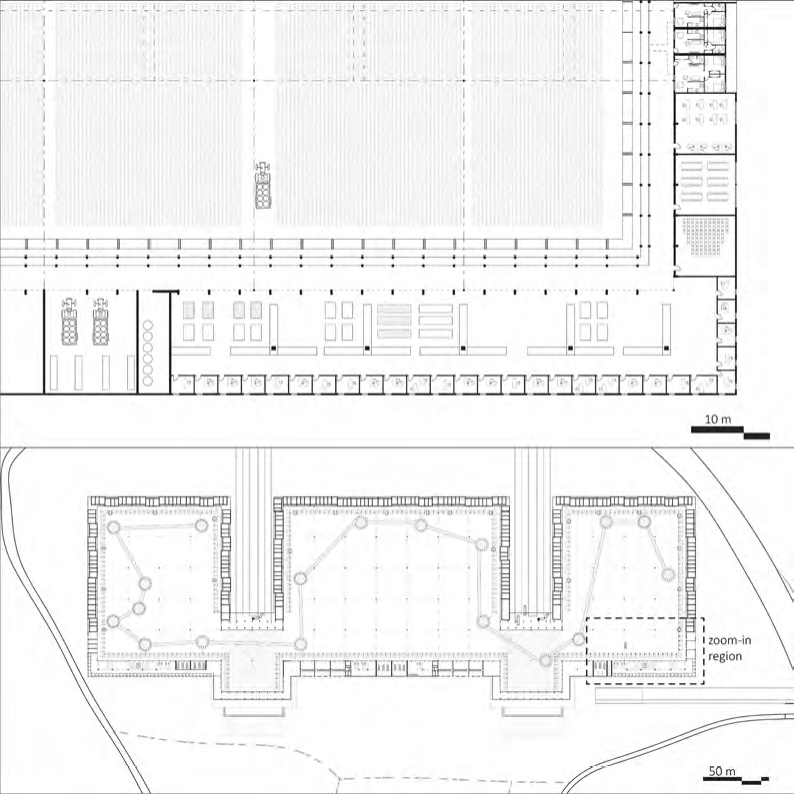 In its three massive greenhouses facilities, the Agro - CoOp produces spinach tomatoes, corn, and chickens for poultry and eggs - products heavily imported from EU countries. The three crops are rotated between the fields, helping to naturally restore nutrients in the soil. This massive enclosed space allows for year-round growing, while scientists are busy studying and improving the plants to maximize production.
In its three massive greenhouses facilities, the Agro - CoOp produces spinach tomatoes, corn, and chickens for poultry and eggs - products heavily imported from EU countries. The three crops are rotated between the fields, helping to naturally restore nutrients in the soil. This massive enclosed space allows for year-round growing, while scientists are busy studying and improving the plants to maximize production.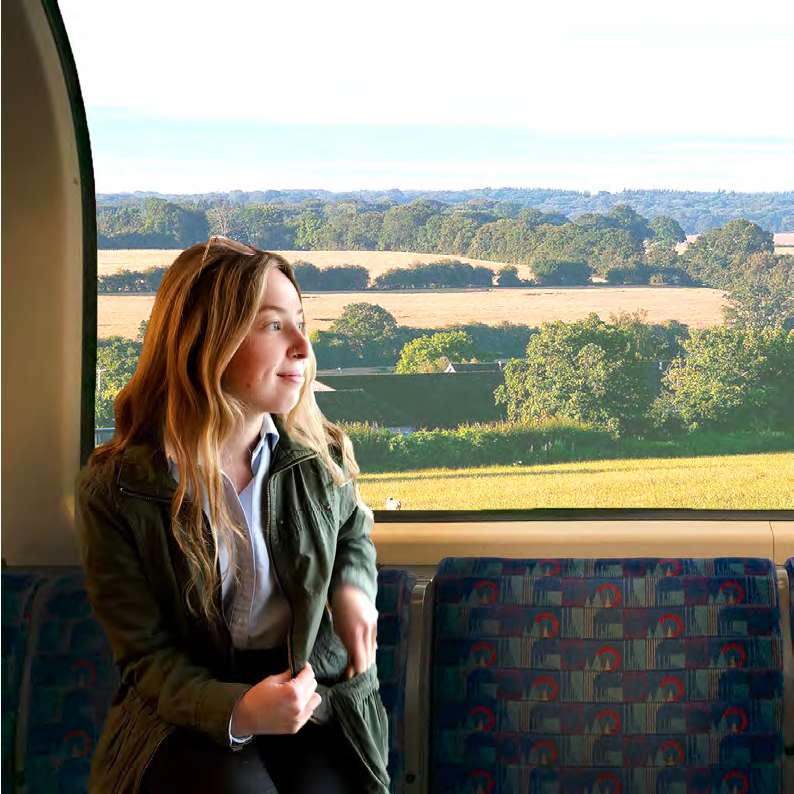 Here we meet Kate, and agricultural researcher from London, on the train towards Uxbridge. Kate enjoys the days when she can leave her work at the bustling University in the city and come out to conduct research in the Agro- CoOp. She looks out the window with excitement as city streets give way to green and yellow fields divided by winding country roads.
Here we meet Kate, and agricultural researcher from London, on the train towards Uxbridge. Kate enjoys the days when she can leave her work at the bustling University in the city and come out to conduct research in the Agro- CoOp. She looks out the window with excitement as city streets give way to green and yellow fields divided by winding country roads.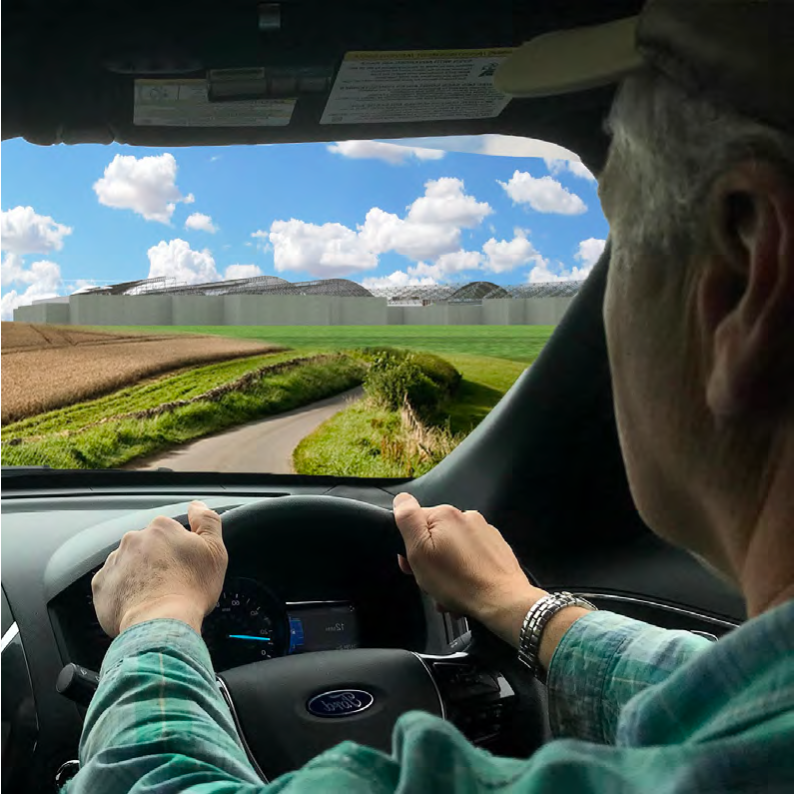 Nearby, Tom, a local farmer, drives down the country road he has known since childhood, growing up on his family’s farm. As he turns the familiar corner, the new massive building emerges, its concrete walls and glass roof rising out of the green fields. Agro-CoOp is certainly unlike anything Tom has ever seen in the neighborhood, but he welcomes the new sight and the change it brings. To keep his farm going, he has taken on a part time job at the new farm compound. Despite his initial doubts, Tom now enjoys teaching the visitors about farming, sharing his life-long passion with them.
Nearby, Tom, a local farmer, drives down the country road he has known since childhood, growing up on his family’s farm. As he turns the familiar corner, the new massive building emerges, its concrete walls and glass roof rising out of the green fields. Agro-CoOp is certainly unlike anything Tom has ever seen in the neighborhood, but he welcomes the new sight and the change it brings. To keep his farm going, he has taken on a part time job at the new farm compound. Despite his initial doubts, Tom now enjoys teaching the visitors about farming, sharing his life-long passion with them.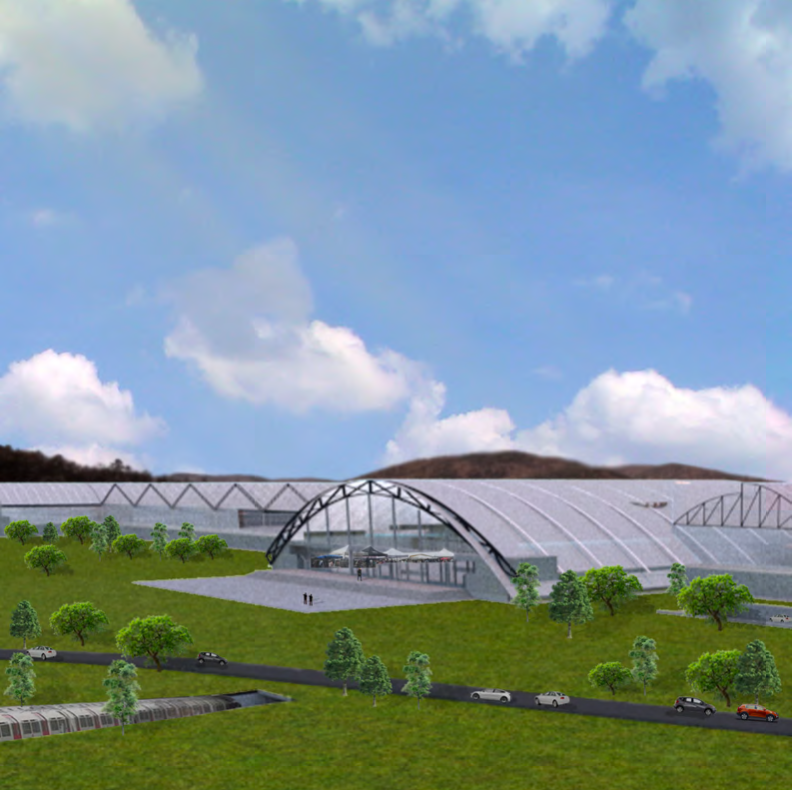 At Agro-CoOp, the urban and rural landscapes meet. The building relies on the vast spaces and productive soil of the fields in which it sits. It also thrives on the steady flow of transportationthe cars and trains which keep its workers and residents well connected to the rest of the city. As the train dives underground and slows to a stop, a truck is pulling into the car park- Kate and Tom are arriving at their destination.
At Agro-CoOp, the urban and rural landscapes meet. The building relies on the vast spaces and productive soil of the fields in which it sits. It also thrives on the steady flow of transportationthe cars and trains which keep its workers and residents well connected to the rest of the city. As the train dives underground and slows to a stop, a truck is pulling into the car park- Kate and Tom are arriving at their destination.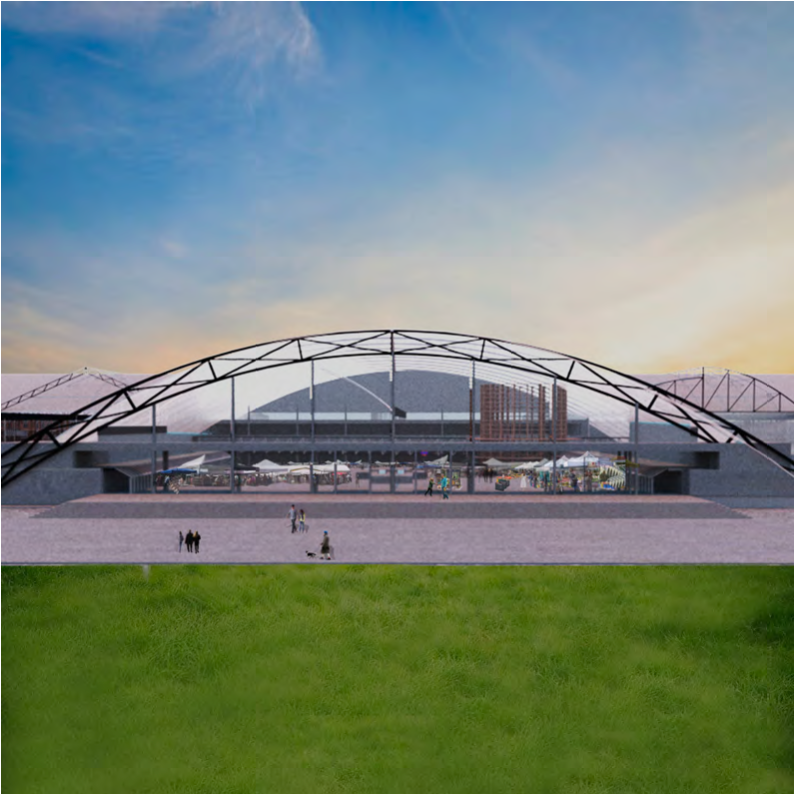 Tom and Kate run into each other at one of the building’s entrances - they’ve gotten to know each other after working together for a few months now. They catch up as they walk towards an entrance to the building. Through the heavy concrete columns and massive truss structure they can see a glimpse of bright light and green leaves.
Tom and Kate run into each other at one of the building’s entrances - they’ve gotten to know each other after working together for a few months now. They catch up as they walk towards an entrance to the building. Through the heavy concrete columns and massive truss structure they can see a glimpse of bright light and green leaves.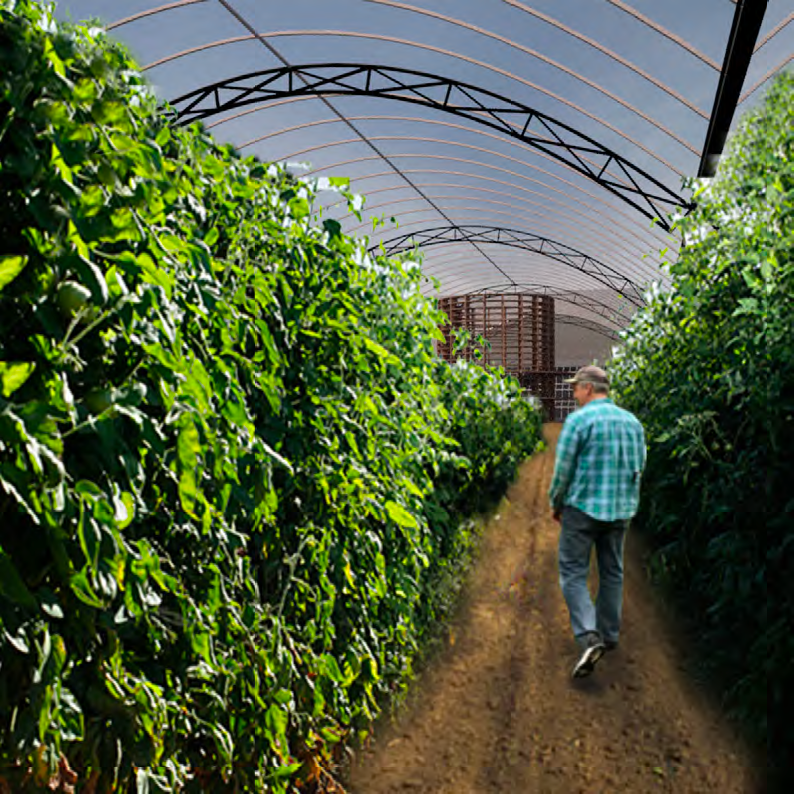 After entering the building, Tom begins his morning work in the tomato fields, planning for what to show the visitors during the tour in the afternoon. Inside the dense grid of tomato plants, Tom is reminded of his family farm.
After entering the building, Tom begins his morning work in the tomato fields, planning for what to show the visitors during the tour in the afternoon. Inside the dense grid of tomato plants, Tom is reminded of his family farm.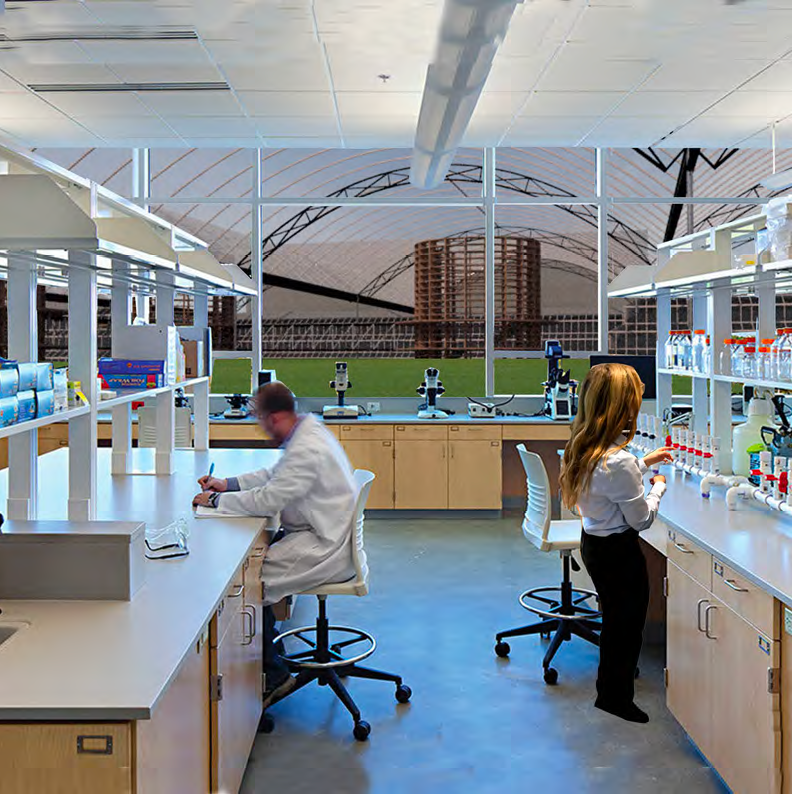 Meanwhile, Kate goes to work in her lab - testing the resilience of the spinach crops. The facilities here provide a unique opportunity that she does not have back in the city -- she can gather large-scale data from the fields of crops, and also utilize the high-tech facilities in the laboratory to conduct experiments. Kate gets to work with a view right out over the fields.
Meanwhile, Kate goes to work in her lab - testing the resilience of the spinach crops. The facilities here provide a unique opportunity that she does not have back in the city -- she can gather large-scale data from the fields of crops, and also utilize the high-tech facilities in the laboratory to conduct experiments. Kate gets to work with a view right out over the fields.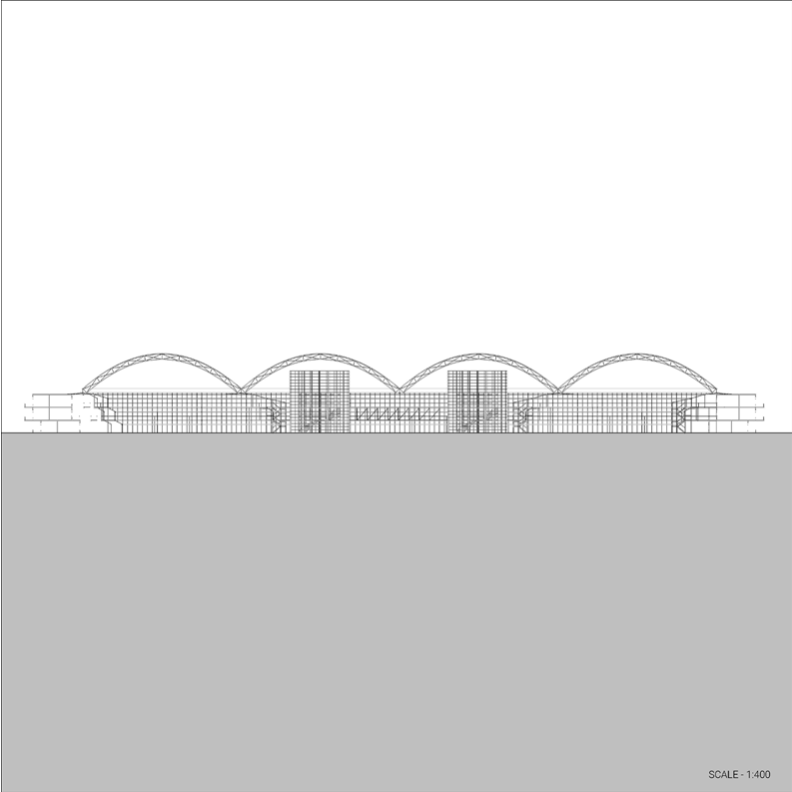 Here we see the greenhouse Tom was walking through. Rows of tomatoes grow, as the glass roof provides natural sunlight and warm temperatures. On either side of the field is the long strip of residential units, made using precast concrete.
Here we see the greenhouse Tom was walking through. Rows of tomatoes grow, as the glass roof provides natural sunlight and warm temperatures. On either side of the field is the long strip of residential units, made using precast concrete.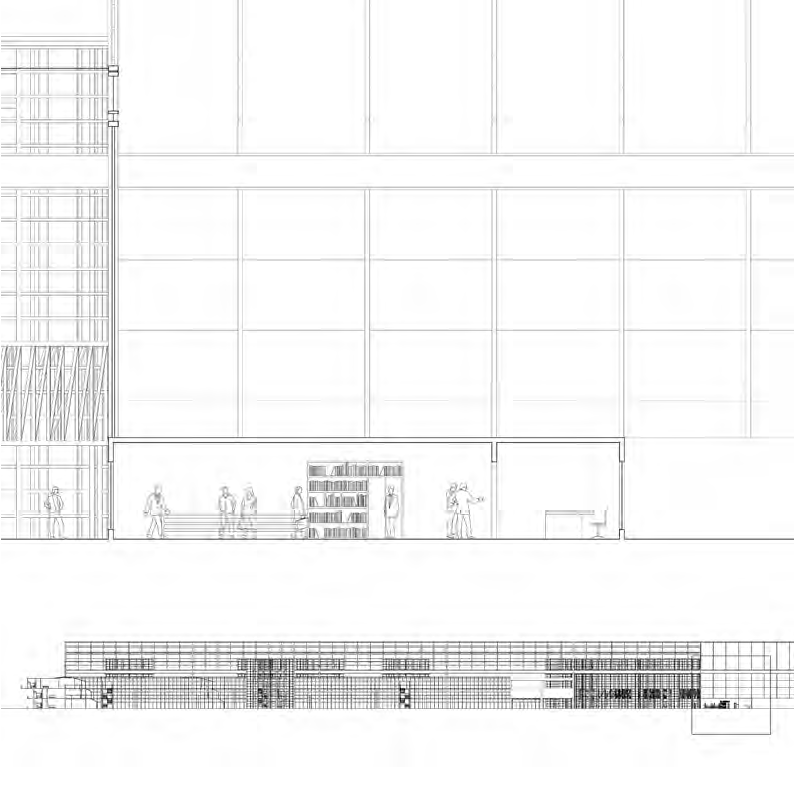 Kate’s lab is in the research space, which sits along the south edge of the building. This side is limited to one-storey, so no larger shadows are cast over the fields where crops grow. Offices and classrooms line the outside edge of the building, shielding the large, open lab space from any direct sun. The desks and glass partitions between each lab can easily be moved to accommodate the changing needs of the scientists’ experiments.
Kate’s lab is in the research space, which sits along the south edge of the building. This side is limited to one-storey, so no larger shadows are cast over the fields where crops grow. Offices and classrooms line the outside edge of the building, shielding the large, open lab space from any direct sun. The desks and glass partitions between each lab can easily be moved to accommodate the changing needs of the scientists’ experiments.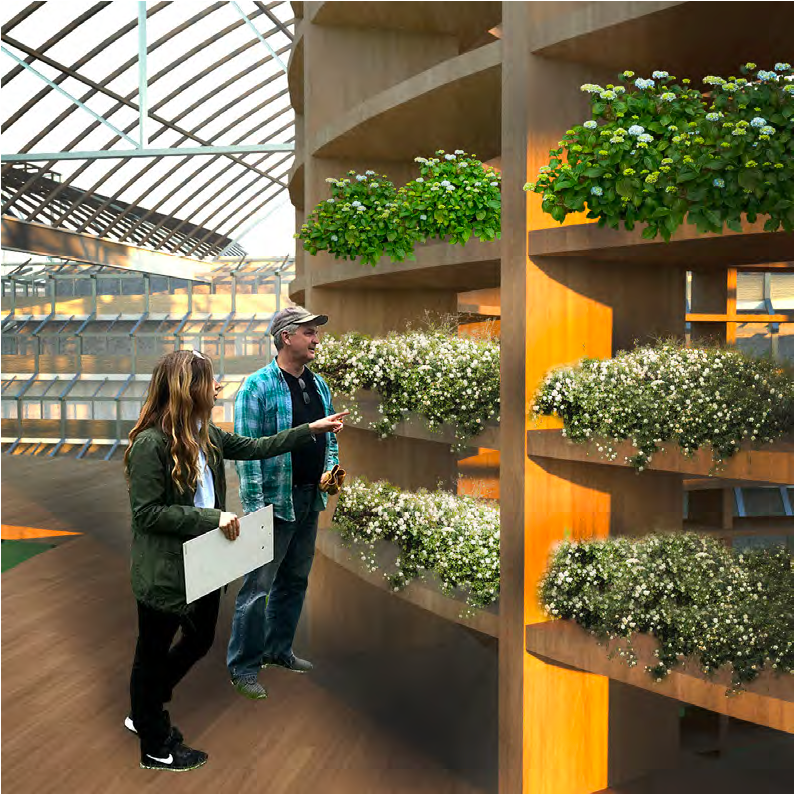 After their morning work is done, Kate and Tom meet up to study the nursery plants in one of the towers. In addition to fresh produce, Agro-CoOp grows seedlings to be sold for home gardens. The top floors of the cylindrical towers dotted throughout the building are utilized for these young plants which need careful attention.
After their morning work is done, Kate and Tom meet up to study the nursery plants in one of the towers. In addition to fresh produce, Agro-CoOp grows seedlings to be sold for home gardens. The top floors of the cylindrical towers dotted throughout the building are utilized for these young plants which need careful attention.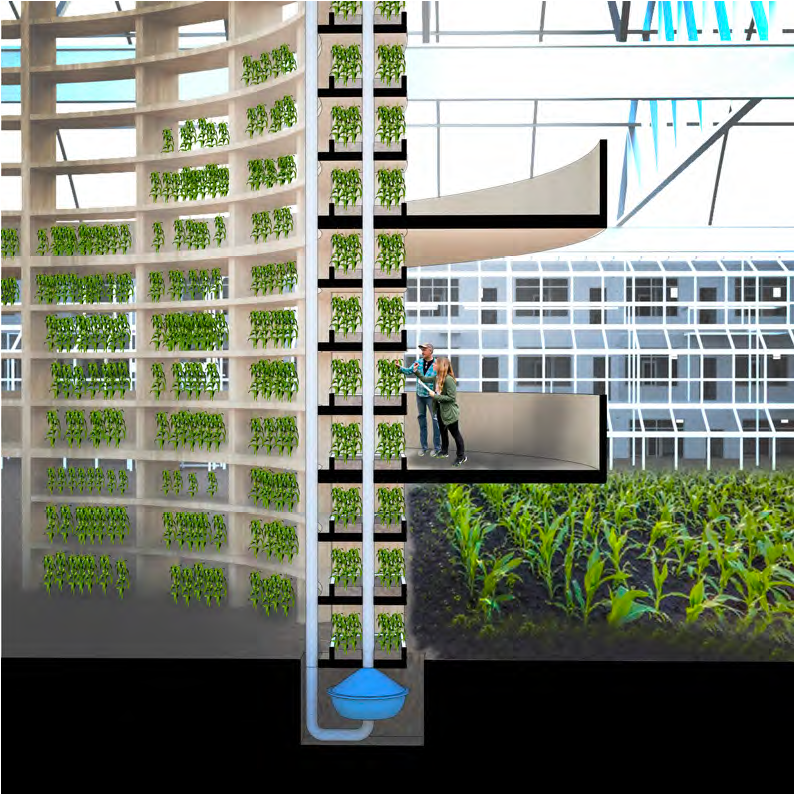 Kate and Tom are inspecting the growth of young plants, which are almost ready to be shipped off. They worked to help develop the irrigation system which runs through the towers to provide water for each plant. They look through each shelf, testing the quality of the soil and ensuring each plant receives the right amount of water.
Kate and Tom are inspecting the growth of young plants, which are almost ready to be shipped off. They worked to help develop the irrigation system which runs through the towers to provide water for each plant. They look through each shelf, testing the quality of the soil and ensuring each plant receives the right amount of water.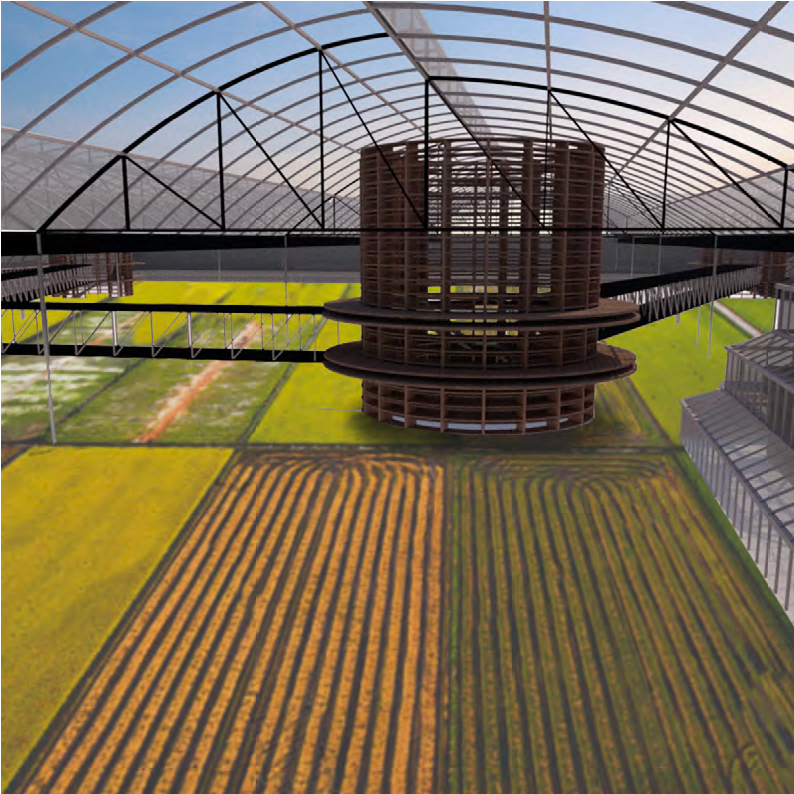 As they finish up, Kate and Tom walk around and look out in the distance. From the high balcony on the tower, they can peer out and see another one of the structures in the distance. Below, the vast fields of green stretch out towards the residential area in the distance.
As they finish up, Kate and Tom walk around and look out in the distance. From the high balcony on the tower, they can peer out and see another one of the structures in the distance. Below, the vast fields of green stretch out towards the residential area in the distance.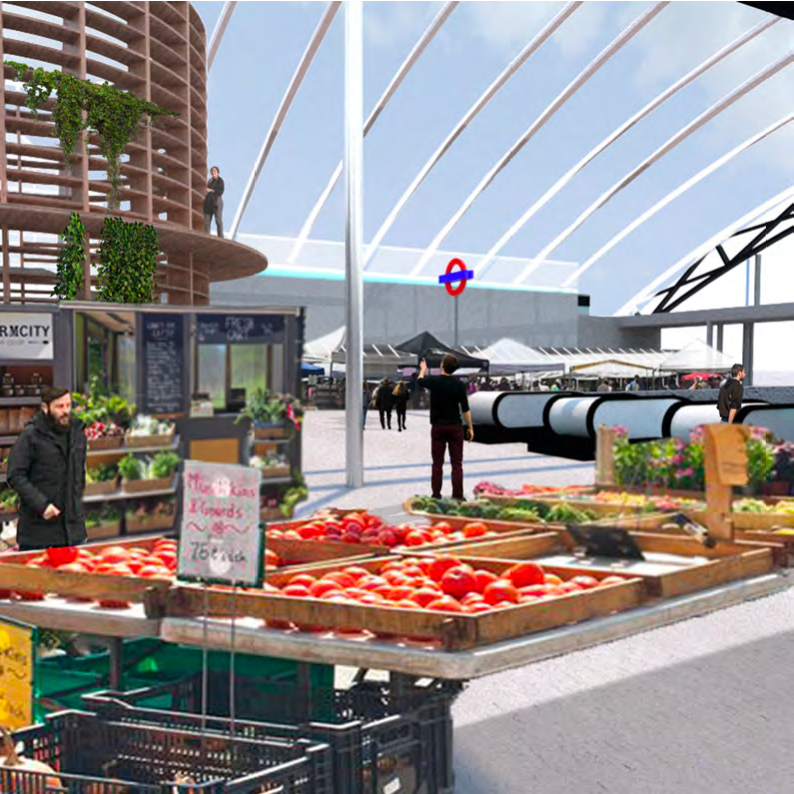 As Tom and Kate leave the tower, a new visitor has just arrived at Agro-CoOp for the first time. Oliver is a young professional who recently moved to London and works in a financial office in Canary Wharf. Oliver is passionate about organic food and sustainable living, but he has never really experienced agricultural first hand--he has lived in a city his whole life. When he heard that Agro-CoOp gave interactive tours, Oliver decided to come visit and learn more about food production.
As Tom and Kate leave the tower, a new visitor has just arrived at Agro-CoOp for the first time. Oliver is a young professional who recently moved to London and works in a financial office in Canary Wharf. Oliver is passionate about organic food and sustainable living, but he has never really experienced agricultural first hand--he has lived in a city his whole life. When he heard that Agro-CoOp gave interactive tours, Oliver decided to come visit and learn more about food production.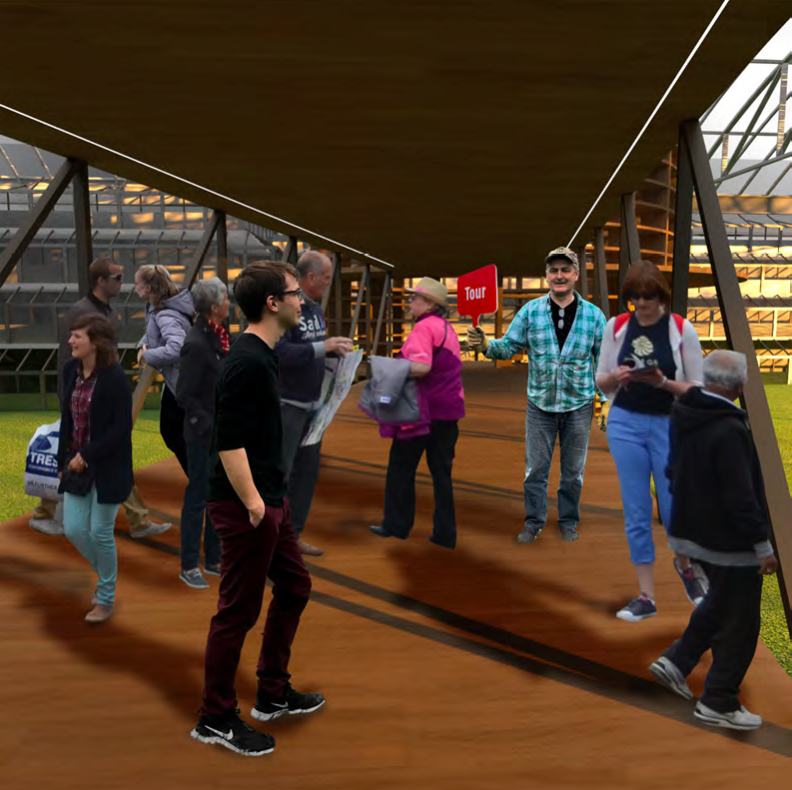 Oliver is surprised by the massive scale of the building he has just entered. He and the other visitors head up to find Tom, who is preparing them for the tour which will start in a few minutes. Tom says they just have to wait for the other tour guide, Reggie, to arrive.
Oliver is surprised by the massive scale of the building he has just entered. He and the other visitors head up to find Tom, who is preparing them for the tour which will start in a few minutes. Tom says they just have to wait for the other tour guide, Reggie, to arrive.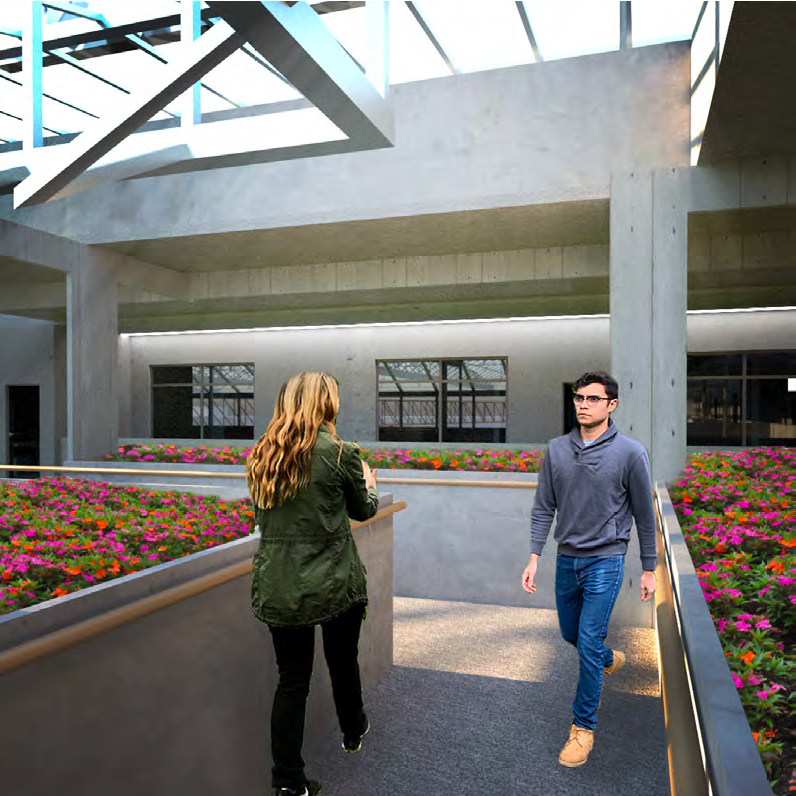 Reggie is walking though one of the corridors to meet up with Tom and the visitors. Reggie moved into the Agro-CoOp right after it opened, amazed at the great price for its location. He was also able to get a job working in the fields and giving tours. While going down the walkway, he sees Kate across the way! They’ve become good friends after working together for a while. Reggie doesn’t have time to chat though, as he’s almost late for the tour which is about to start.
Reggie is walking though one of the corridors to meet up with Tom and the visitors. Reggie moved into the Agro-CoOp right after it opened, amazed at the great price for its location. He was also able to get a job working in the fields and giving tours. While going down the walkway, he sees Kate across the way! They’ve become good friends after working together for a while. Reggie doesn’t have time to chat though, as he’s almost late for the tour which is about to start.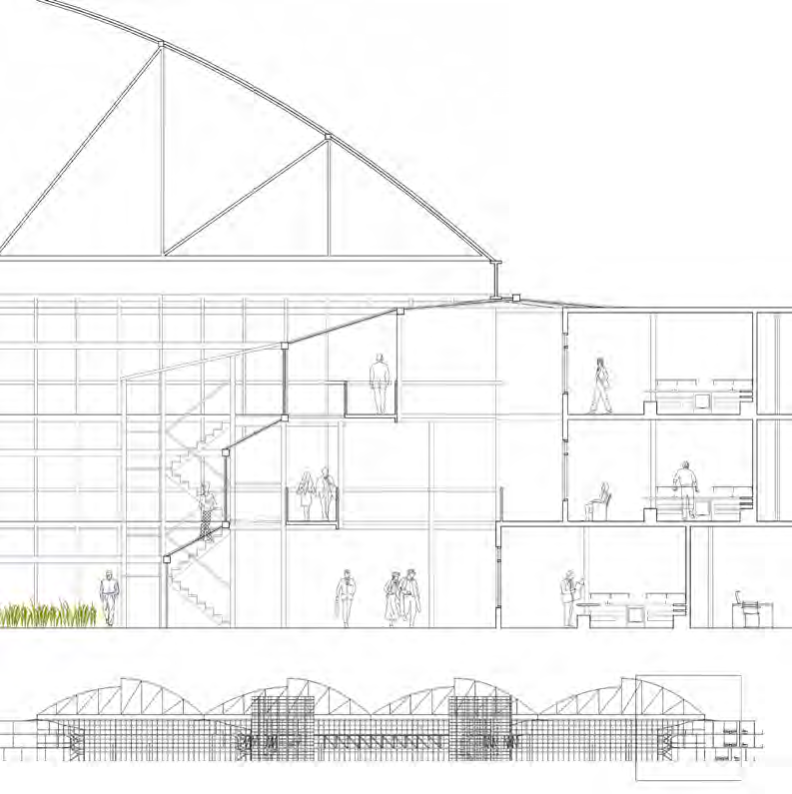 The corridor where Reggie and Kate crossed paths is part of
the circulation area that wraps around the interior facade of the
building. In this zone, residents and workers walk by from one end
of the building to the other. The space acts as a buffer between
the flats and the fields, while using glass to maintain a visual
connection. The space is filled with elevated platforms which act
like a street for the residences, helping to foster the sense of
community among the people who live here.
The corridor where Reggie and Kate crossed paths is part of
the circulation area that wraps around the interior facade of the
building. In this zone, residents and workers walk by from one end
of the building to the other. The space acts as a buffer between
the flats and the fields, while using glass to maintain a visual
connection. The space is filled with elevated platforms which act
like a street for the residences, helping to foster the sense of
community among the people who live here.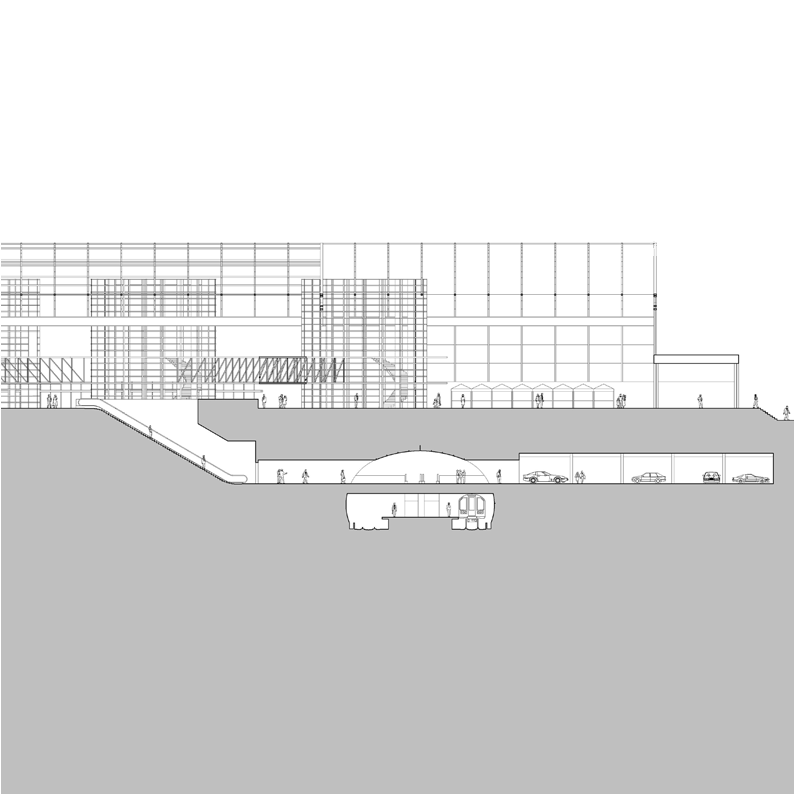 On the other hand, the wide open entrance space is the public face of the building. Here, Reggie meets up with Tom to greet Oliver and the other visitors. People enter through one side, while trucks and tractors can access the back entry, bringing in supplies and carrying out products. Visitors can freely enter the marketplace area during opening hours, but have to sign up for a guided tour in order to see the greenhouse facilities.
On the other hand, the wide open entrance space is the public face of the building. Here, Reggie meets up with Tom to greet Oliver and the other visitors. People enter through one side, while trucks and tractors can access the back entry, bringing in supplies and carrying out products. Visitors can freely enter the marketplace area during opening hours, but have to sign up for a guided tour in order to see the greenhouse facilities.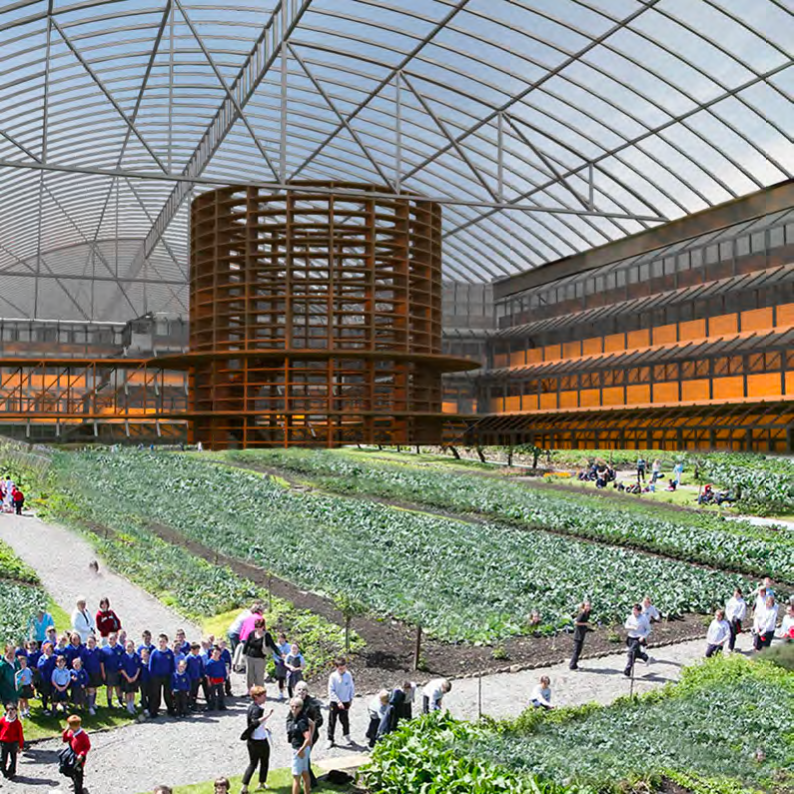 Visitors are welcomed at Agro-CoOp, including school children, university students, and tourists from around the world who want to see this unique building. The mission of Agro-CoOp is twofold - it helps to provide food and housing for London residents, and it also seeks to educate the public, raising awareness about the importance of sustainable agriculture practices.
Visitors are welcomed at Agro-CoOp, including school children, university students, and tourists from around the world who want to see this unique building. The mission of Agro-CoOp is twofold - it helps to provide food and housing for London residents, and it also seeks to educate the public, raising awareness about the importance of sustainable agriculture practices.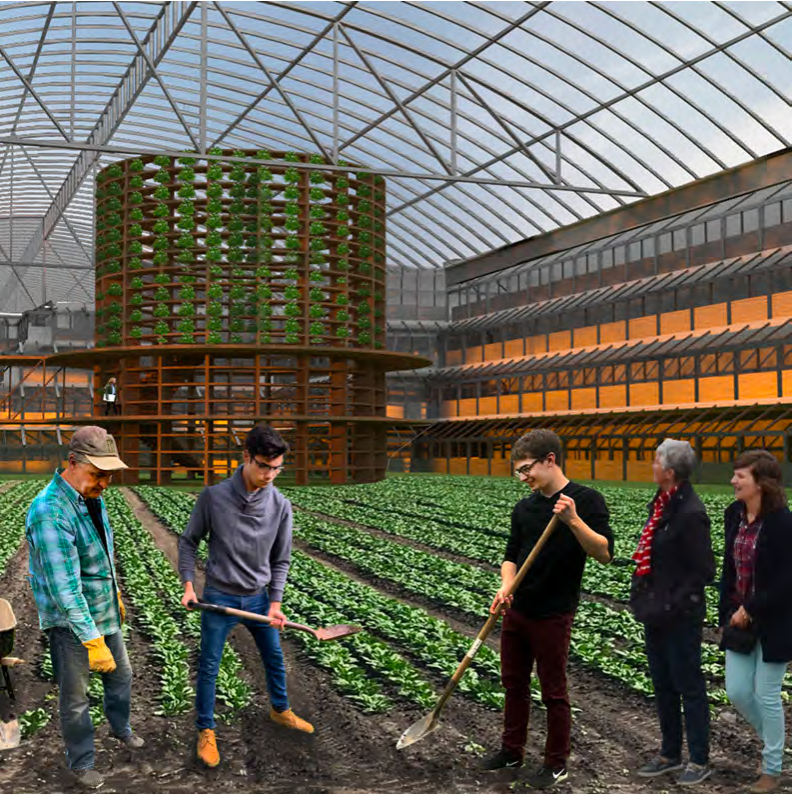 Moving on with their tour, Reggie and Tom are now explaining to the visitors how they could start their own home garden, giving some tips on the right tools and the best time to plant. Oliver is really enjoying the chance to get his hands dirty and learn more about farming. Seeing the countless rows of deep green spinach, he thinks maybe he could grow a small pot of lettuce in his own apartment.
Moving on with their tour, Reggie and Tom are now explaining to the visitors how they could start their own home garden, giving some tips on the right tools and the best time to plant. Oliver is really enjoying the chance to get his hands dirty and learn more about farming. Seeing the countless rows of deep green spinach, he thinks maybe he could grow a small pot of lettuce in his own apartment. Tom and Reggie then move on with the group into the chicken zone, which is usually a big crowd-pleaser. People love to see the birds free to roam around the fields and peck at the grass, much different from the terrible pictures they have seen of cramped industrial chicken houses. Reggie points out how some of the grains which the chickens eat are grown right here in the building.
Tom and Reggie then move on with the group into the chicken zone, which is usually a big crowd-pleaser. People love to see the birds free to roam around the fields and peck at the grass, much different from the terrible pictures they have seen of cramped industrial chicken houses. Reggie points out how some of the grains which the chickens eat are grown right here in the building.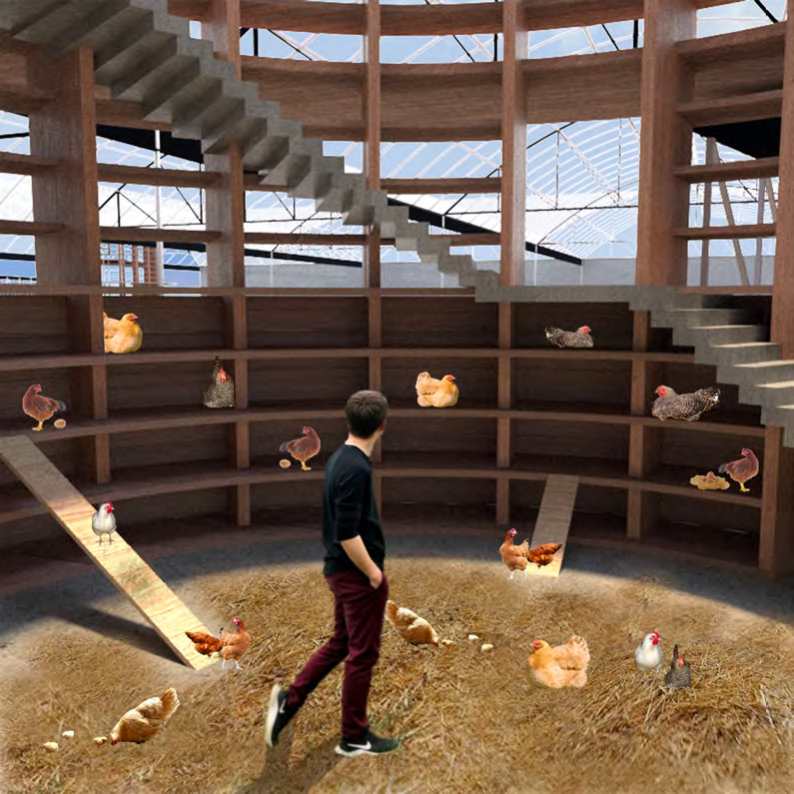 Next, they venture into the bottom of one of the towers. Several of the bottom levels are used to house the chickens. Oliver is very impressed with the unique space inside the vertical structure, where natural light filters down through the leaves above. All the visitors are allowed to gather some eggs to take home with them!
Next, they venture into the bottom of one of the towers. Several of the bottom levels are used to house the chickens. Oliver is very impressed with the unique space inside the vertical structure, where natural light filters down through the leaves above. All the visitors are allowed to gather some eggs to take home with them!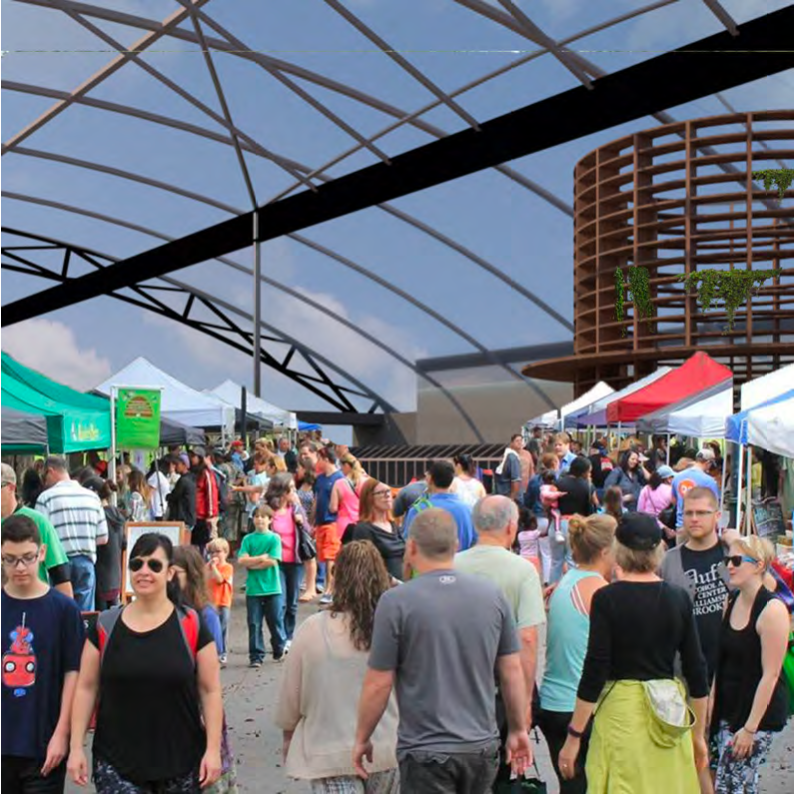 Gathering the eggs marked the last bit of the tour, and visitors are now heading off. Oliver sticks around afterwards, with Reggie to do some shopping in the farmer’s market. Reggie mentions that there’s a big public festival happening tomorrow.
Gathering the eggs marked the last bit of the tour, and visitors are now heading off. Oliver sticks around afterwards, with Reggie to do some shopping in the farmer’s market. Reggie mentions that there’s a big public festival happening tomorrow.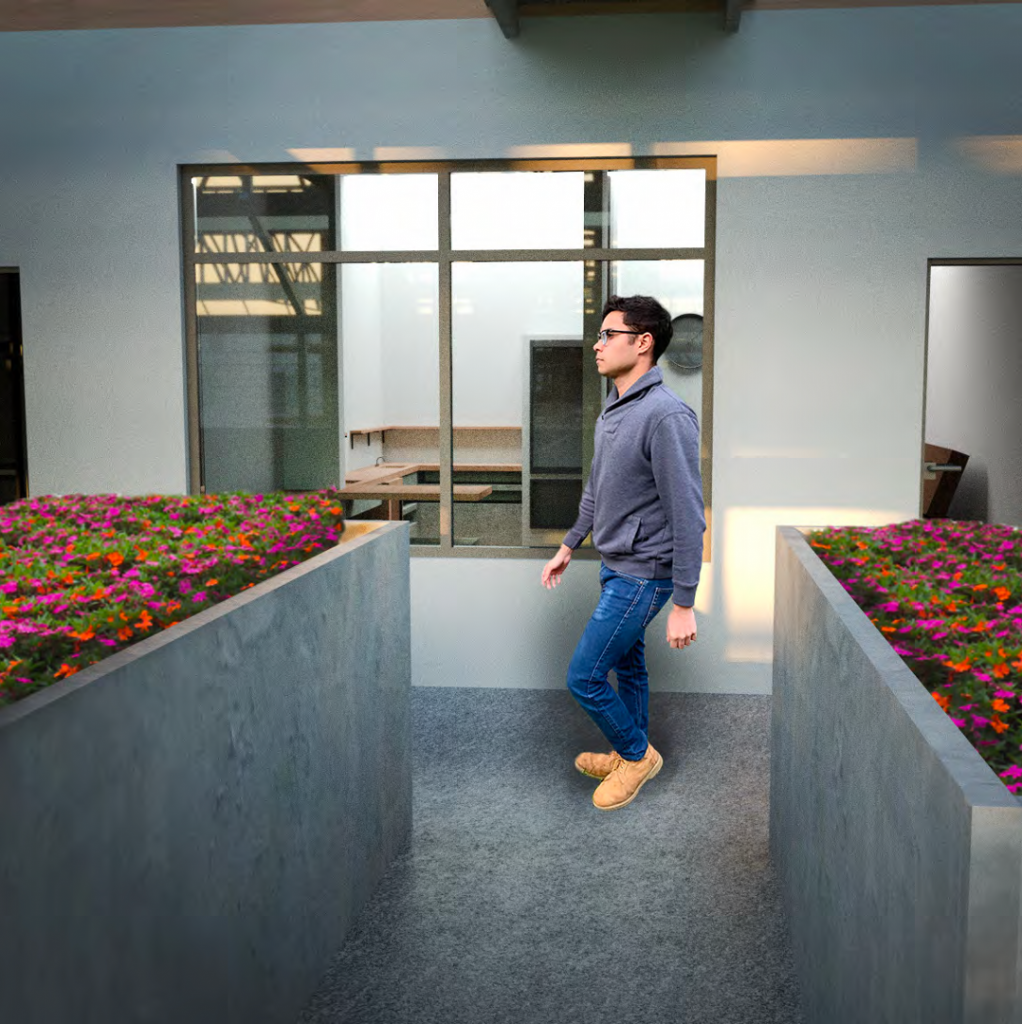 With his bag of fresh groceries, Reggie heads home for the night after a long day. He’s a bit tired from his work, so he’s glad he doesn’t have to worry about a commute home. From the market, it’s just a three-minute walk back to his flat, a cozy onebedroom unit.With his bag of fresh groceries, Reggie heads home for the night after a long day. He’s a bit tired from his work, so he’s glad he doesn’t have to worry about a commute home. From the market, it’s just a three-minute walk back to his flat, a cozy one-bedroom unit.
With his bag of fresh groceries, Reggie heads home for the night after a long day. He’s a bit tired from his work, so he’s glad he doesn’t have to worry about a commute home. From the market, it’s just a three-minute walk back to his flat, a cozy onebedroom unit.With his bag of fresh groceries, Reggie heads home for the night after a long day. He’s a bit tired from his work, so he’s glad he doesn’t have to worry about a commute home. From the market, it’s just a three-minute walk back to his flat, a cozy one-bedroom unit.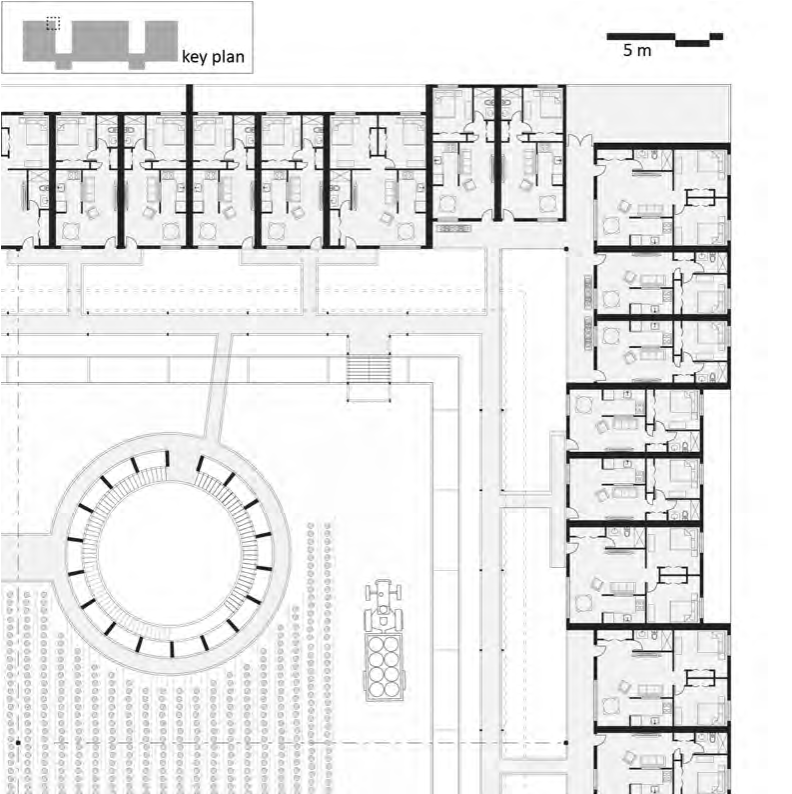 Here we see a close-up view of Reggie’s typical one bedroom flat. Every unit benefits from views both outside and into the greenhouse space. The building has both one and two bedroom flats, marketed mostly towards young singles and couples - many of them commuting to the city each day for work.
Here we see a close-up view of Reggie’s typical one bedroom flat. Every unit benefits from views both outside and into the greenhouse space. The building has both one and two bedroom flats, marketed mostly towards young singles and couples - many of them commuting to the city each day for work.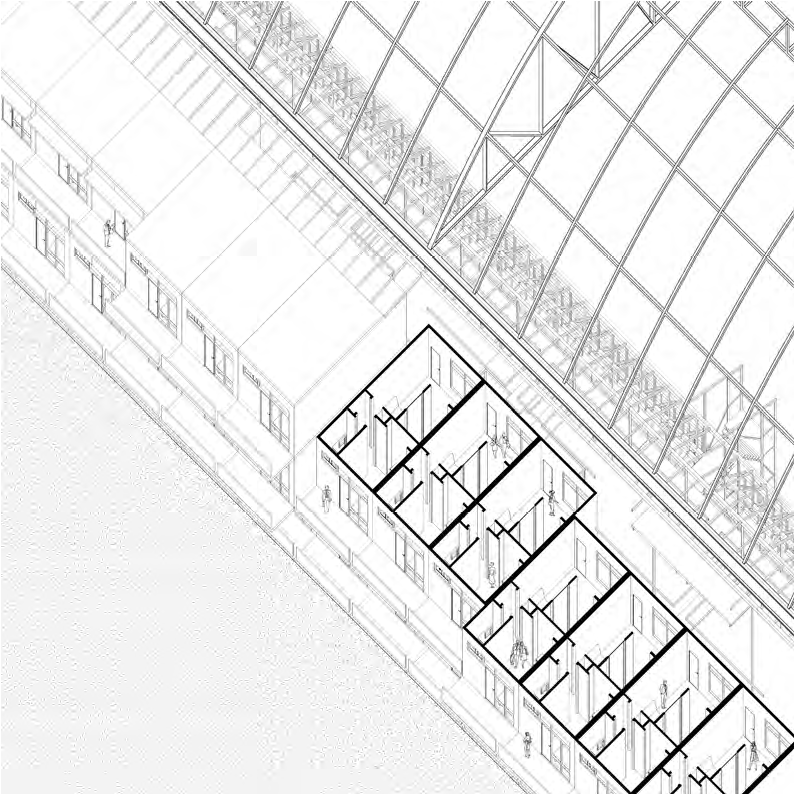 Groupings of three flats are staggered to break up the long facades of the building. The groupings give residents a sense of smaller-scaled community living, with two close neighbors to share the front balcony with.
Groupings of three flats are staggered to break up the long facades of the building. The groupings give residents a sense of smaller-scaled community living, with two close neighbors to share the front balcony with.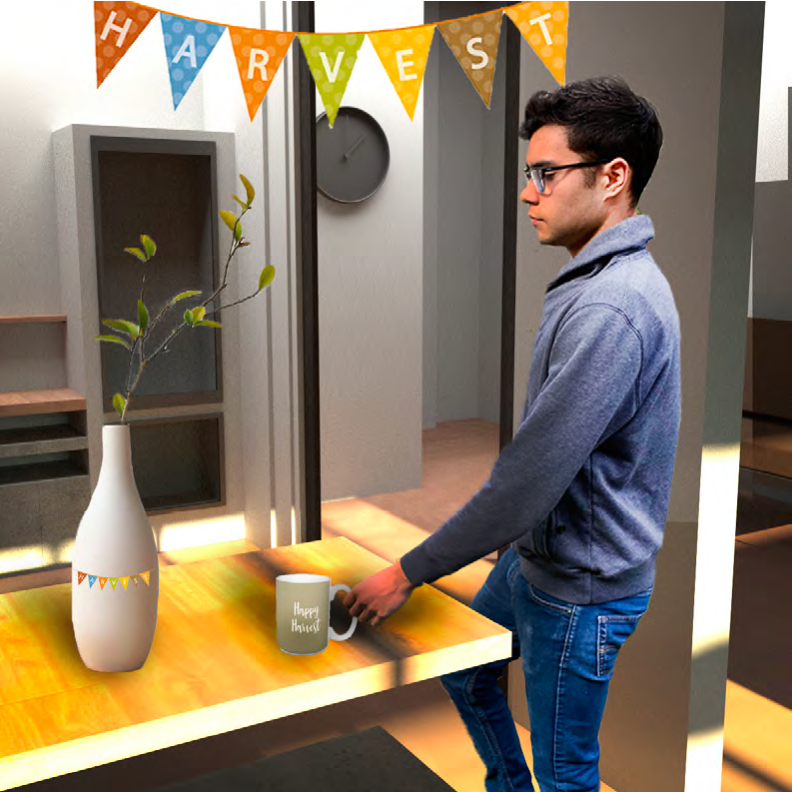 Reggie wakes up the next morning with a sense of excitement--today is the beginning of Agro-CoOp’s annual harvest festival! He already had put up some decorations in anticipation of the day full of festivities.Reggie wakes up the next morning with a sense of excitement--today is the beginning of Agro-CoOp’s annual harvest festival! He already had put up some decorations in anticipation of the day full of festivities.
Reggie wakes up the next morning with a sense of excitement--today is the beginning of Agro-CoOp’s annual harvest festival! He already had put up some decorations in anticipation of the day full of festivities.Reggie wakes up the next morning with a sense of excitement--today is the beginning of Agro-CoOp’s annual harvest festival! He already had put up some decorations in anticipation of the day full of festivities.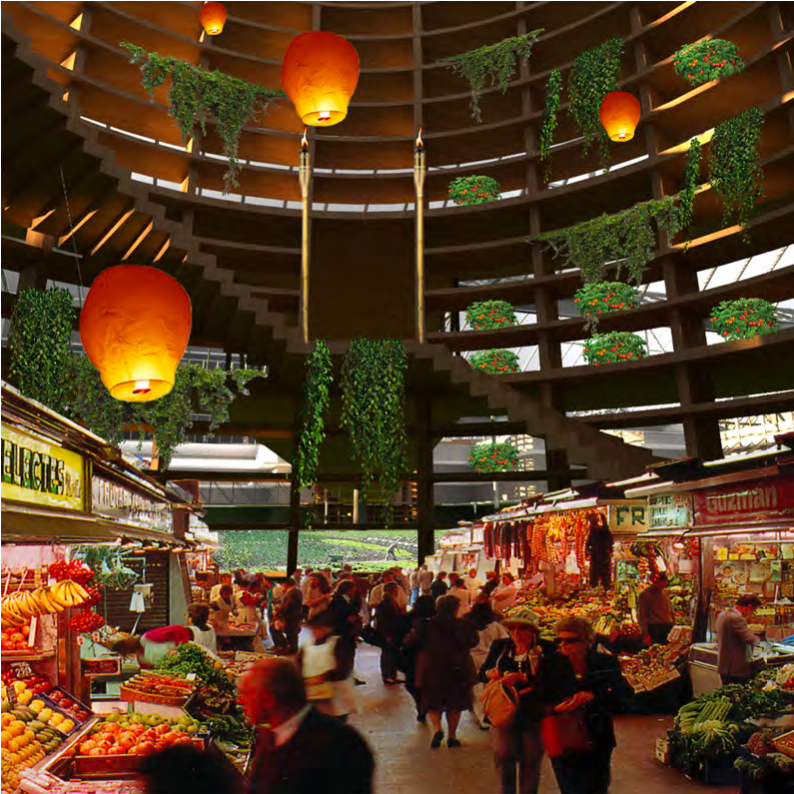 The community has come together to celebrate the autumn season of harvest - a tradition shared by many cultures around the world. Here, one of the towers has been filled with decorations and goods for sale. Many people make the trip out to spend a day shopping, eating, and celebrating.
The community has come together to celebrate the autumn season of harvest - a tradition shared by many cultures around the world. Here, one of the towers has been filled with decorations and goods for sale. Many people make the trip out to spend a day shopping, eating, and celebrating.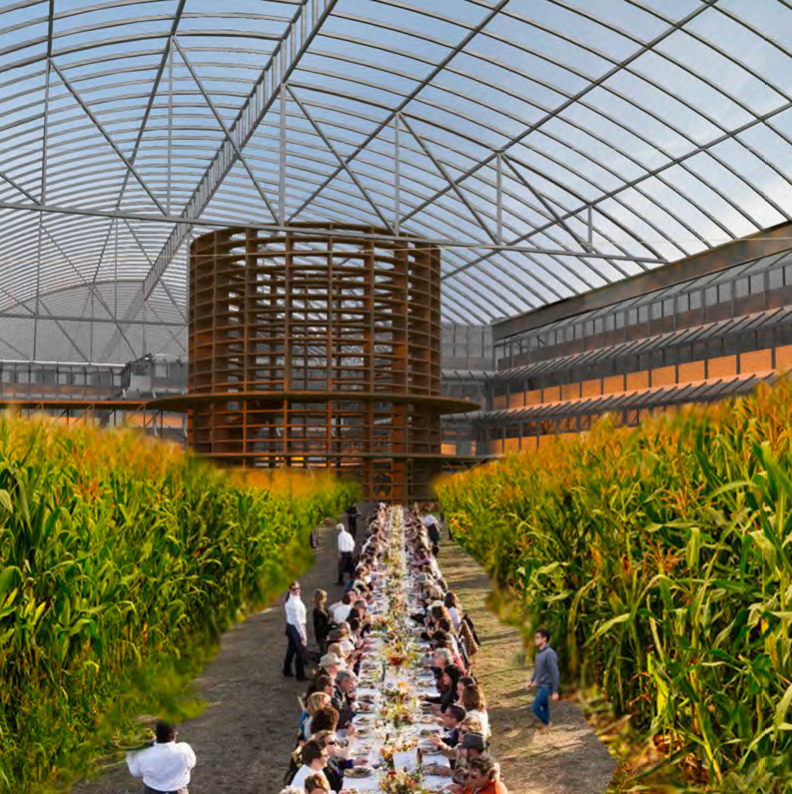 In the afternoon, Reggie and other residents and workers all gather for a community pot-luck. Everyone brings a favorite dish to share, and the dinner goes on for several hours as people chat with friends and meet new people they haven’t gotten to know yet. Sharing food breaks down any social barriers, as people from many different backgrounds come together and learn from each other.
In the afternoon, Reggie and other residents and workers all gather for a community pot-luck. Everyone brings a favorite dish to share, and the dinner goes on for several hours as people chat with friends and meet new people they haven’t gotten to know yet. Sharing food breaks down any social barriers, as people from many different backgrounds come together and learn from each other.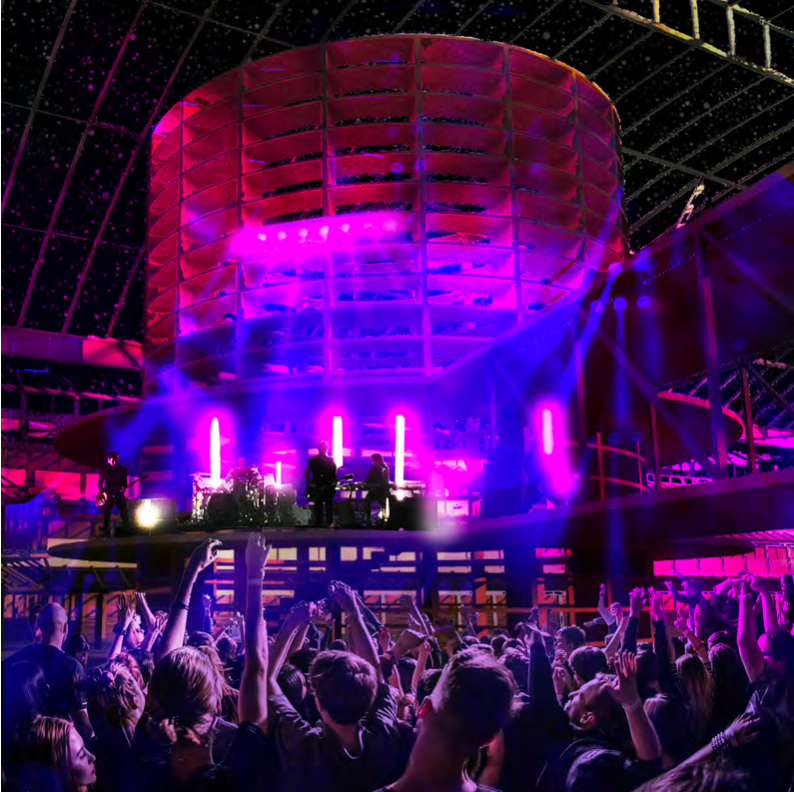 As the sun goes down, Reggie joins a crowd of people dancing to the beat of loud music-- a very unusual scene in the spaces which he usually knows to be peaceful and quiet. The concert is a great way to bring in large crowds to visit the space. Many of these people never would have thought to visit a greenhouse until they saw their favorite band was coming to perform!
As the sun goes down, Reggie joins a crowd of people dancing to the beat of loud music-- a very unusual scene in the spaces which he usually knows to be peaceful and quiet. The concert is a great way to bring in large crowds to visit the space. Many of these people never would have thought to visit a greenhouse until they saw their favorite band was coming to perform!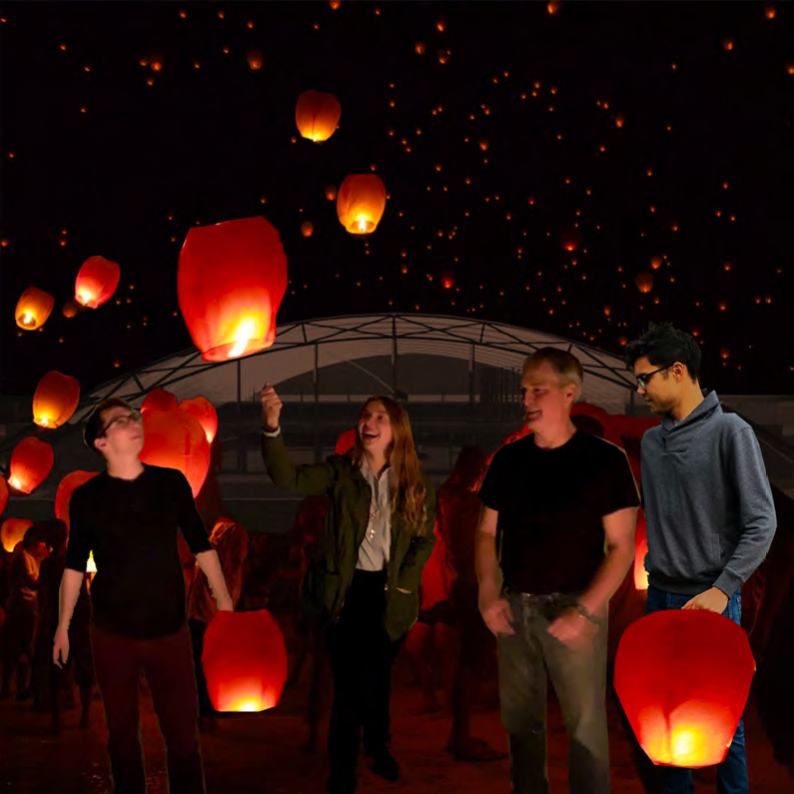 At the end of the night, the community then gathers outside to release lanterns. Reggie, Kate, Tom, and Oliver are all finally coming together and marveling at the spectacle. The light of the lanterns shimmers in the sky and reflects off the huge glass roof, marking the end of the day’s celebration.
At the end of the night, the community then gathers outside to release lanterns. Reggie, Kate, Tom, and Oliver are all finally coming together and marveling at the spectacle. The light of the lanterns shimmers in the sky and reflects off the huge glass roof, marking the end of the day’s celebration. Finally, Reggie is back home at his single bedroom apartment, marking the end of the Harvest Festival. This special day is a reminder of how much he enjoys the community he lives with every day here at Agro-CoOp.
Finally, Reggie is back home at his single bedroom apartment, marking the end of the Harvest Festival. This special day is a reminder of how much he enjoys the community he lives with every day here at Agro-CoOp. Welcome to the world of Agro-CoOp, London’s innovative new center for agricultural production and research. Completed in 2023, the massive structure is intended to address London’s two most essential needs: affordable housing and fresh, local food. Just outside Uxbridge, the building is connected to the thriving life of the city and the scenic countryside via underground train and highway. Here it sits at the intersection of two worlds: the urban metropolis and the productive landscape of the greenbelt.
Welcome to the world of Agro-CoOp, London’s innovative new center for agricultural production and research. Completed in 2023, the massive structure is intended to address London’s two most essential needs: affordable housing and fresh, local food. Just outside Uxbridge, the building is connected to the thriving life of the city and the scenic countryside via underground train and highway. Here it sits at the intersection of two worlds: the urban metropolis and the productive landscape of the greenbelt.





























